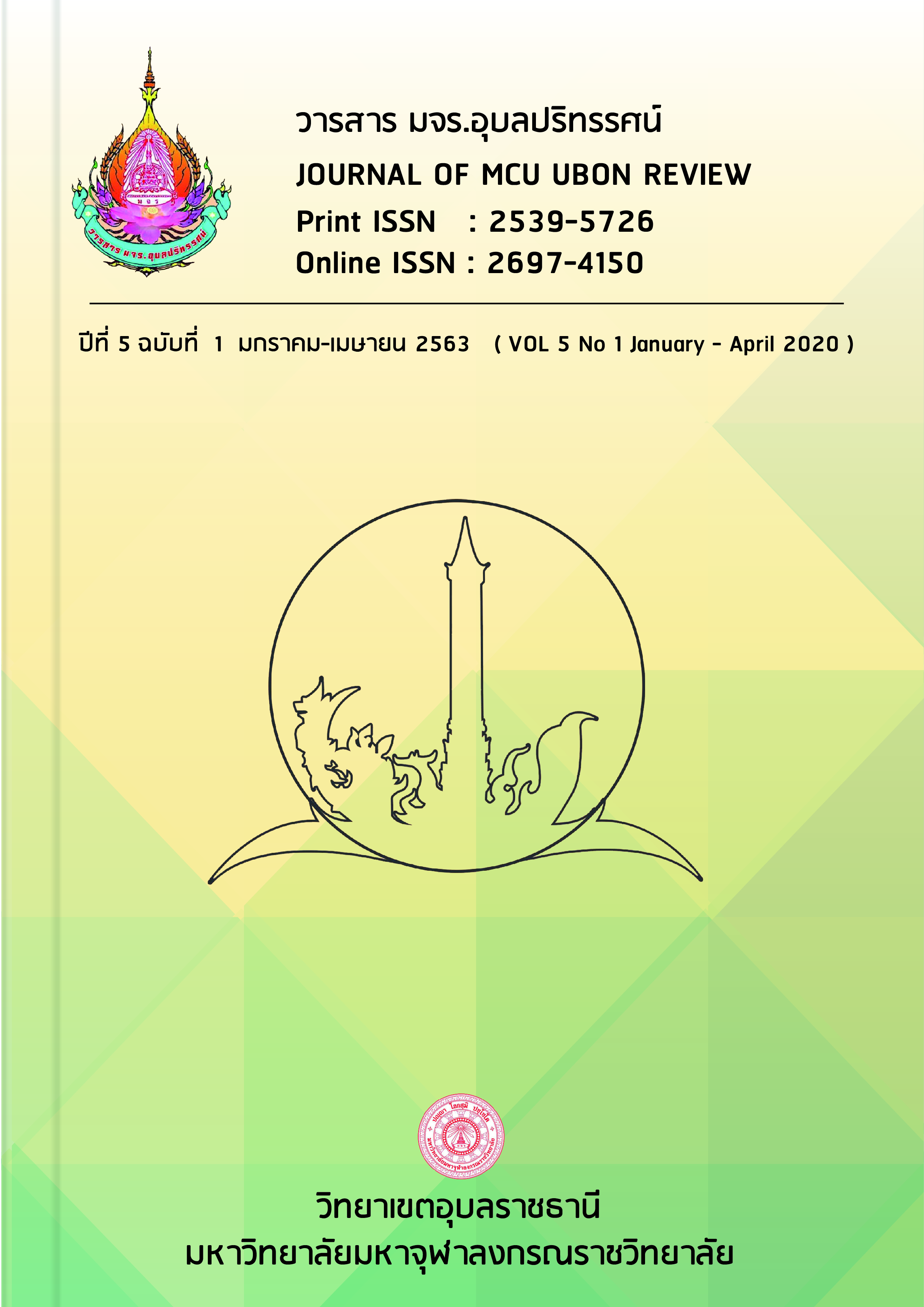แรงจูงใจในการทำงาน : ทฤษฎีและการประยุกต์ใช้
Main Article Content
บทคัดย่อ
บทความนี้เป็นบทความวิชาการเพื่อนำเสนอแรงจูงใจในการทำงาน ทฤษฎีและการประยุกต์ใช้ การจูงใจเป็นกระบวนการที่บุคคลถูกกระตุ้นจากสิ่งเร้าโดยจงใจให้กระทำถึงการประยุกต์ทฤษฎีแรงจูงใจให้เป็นแนวทางในการทำงาน ซึ่งสามารถแบ่งได้ดังนี้ คือ 1. กลุ่มทฤษฎีเนื้อหาครอบคลุมถึงทฤษฎีลำดับขั้นความต้องการ ทฤษฎีแรงจูงใจภายใน และทฤษฎีแรงจูงใจภายนอก ประกอบด้วย 1) ทฤษฎี Abraham Maslow 2) ทฤษฎี Two-Factor 3) ทฤษฎี X และทฤษฎี Y 4) ทฤษฎี ERG และ 2. กลุ่มทฤษฎีกระบวนการ รวมถึงทฤษฎีการกำหนดเป้าหมาย ทฤษฎีความเป็นธรรม ทฤษฎีความคาดหวัง และรวมทั้งนำเสนอแนวทางการพัฒนาแรงจูงใจในการทำงาน จากทฤษฎีแรงจูงใจข้างต้น จึงมีการประยุกต์แรงจูงใจเพื่อใช้ในการปฏิบัติงานและสามารถนำไปใช้ในสถานการณ์จริงได้อย่างเหมาะสม
Article Details
ประเภทบทความ
Academic Article
เอกสารอ้างอิง
จักรี ศรีจารุเมธีญาณ. (2560). เอกสารประกอบการสอน รายวิชา การบริหารทรัพยากรมนุษย์ในภาครัฐ. มหาวิทยาลัยมหามกุฏราชวิทยาลัย วิทยาเขตอีสาน. จังหวัดขอนแก่น. หน้า 147.
ณัฏฐ์พัชร์ ลาภบำรุงวงศ์. (2562). การประยุกต์ทฤษฎีแรงจูงใจในการปฏิบัติงาน. วารสารวไลยอลงกรณ์ปริทัศน์ (มนุษยศาสตร์และสังคมศาสตร์) ปีที่ 9 ฉบับที่ 2 พฤษภาคม – สิงหาคม 2562. หน้า 167 – 168.
ปฐมวงค์ สีหาเสนา. (2557). แรงจูงใจในการปฏิบัติงานของบุคลากรเทศบาลตำบลค่ายเนินวง ตำบลบางกะจะ อำเภอเมืองจันทบุรี จังหวัดจันทบุรี. หลักสูตรรัฐประศาสนศาสตรมหาบัณฑิต สาขาวิชาการจัดการ มหาวิทยาลัยบูรพา.
อรพินทร์ ชูชม. (2555). แรงจูงใจใน การทํางาน: ทฤษฎีและการประยุกต์. วารสารจิตวิทยา. มหาวิทยาลัยเกษม บัณฑิต ปีที่ 2. ฉบับที่ 2 มกราคม - ธันวาคม 2555. หน้า 52-61.
อรพินทร์ ชูชม, อัจฉรา สุขารมณ์ และ วิลาสลักษณ์ ชัววัลลี. (2542). การพัฒนาแบบวัดแรงจูงใจ ภายใน. กรุงเทพฯ: สถาบันวิจัยพฤติกรรมศาสตร์ มหาวิทยาลัยศรีนครินทรวิโรฒ.
อรพินทร์ ชูชม, อัจฉรา สุขารมณ์ และ อังศินันท์ อินทรกำแหง. (2553). การวิเคราะห์ความสัมพันธ์ระหว่าง ครอบครัว งานกับคุณภาพชีวิต. วารสารพฤติกรรมศาสตร์, 16(2), 32-49.
Amabile, T. M. (1993). Motivational synergy: Toward new conceptualization of intrinsic and extrinsic motivation in the workplace. Human Resource Management Review, 3(3), 185- 201.
Barnes, S. J., & Pressey, A. D. (2012). Who needs real-life? Examining needs in virtual worlds. Journal of Computer Information Systems. 52(4), 40-48.
Disley, P., Hatton, C., & Dagnan, D. (2009). Applying equity theory to staff working with individuals with intellectual disabilities. Journal of Intellectual & Development Disability, 34(1), 55-66.
Frederick, W. Tr. (1911). The Principles of Scientific Management. New York: Harper and Brothers.
Herzberg,F., Bernard, M. & Snyderman, B. (1959). The Motivation to Work. New York: John Willey & Sons.
Latham, G. P., & Pinder, C. C. (2005). Work motivation theory and research at the dawn of the twenty-first century. Annual Review of Psychology, 56, 485-516.
layton,P. A. (1972). Existence, Relatedness & Growth: Human Needs in Organizational Setting. New York: The Free Press.
Loudon, D. L., & Bitta, D. A. J.(1988). Consummer Behavior: Concept and Applications. (3 rded). New York: McGraw-Hill.
Maslow, A.H. (1943). A Theory of Human Motivation. Psychological Review, p.370-396.
McGregor, D. (1960). The Human Side of Enterprise. New York: McGraw-Hill.
Pinder, C. (1998). Work Motivation in Organizational Behavior. Upper Saddle River, NJ: Prentice- Hall.
Gagne, M., & Deci, E. (2005). Self-determination theory and work motivation. Journal of Organizational Behavior. 26, 331-362.
Walter, K. (1978). The Working Class in Welfare Capitalism.London : Routledge & Kegan Paul.
Wahba, M. A., & Bridwell, L. G. (1973). Maslow reconsidered: A review of research on the needhierarchy theory. Academy of Management Proceedings. 514-520.
ณัฏฐ์พัชร์ ลาภบำรุงวงศ์. (2562). การประยุกต์ทฤษฎีแรงจูงใจในการปฏิบัติงาน. วารสารวไลยอลงกรณ์ปริทัศน์ (มนุษยศาสตร์และสังคมศาสตร์) ปีที่ 9 ฉบับที่ 2 พฤษภาคม – สิงหาคม 2562. หน้า 167 – 168.
ปฐมวงค์ สีหาเสนา. (2557). แรงจูงใจในการปฏิบัติงานของบุคลากรเทศบาลตำบลค่ายเนินวง ตำบลบางกะจะ อำเภอเมืองจันทบุรี จังหวัดจันทบุรี. หลักสูตรรัฐประศาสนศาสตรมหาบัณฑิต สาขาวิชาการจัดการ มหาวิทยาลัยบูรพา.
อรพินทร์ ชูชม. (2555). แรงจูงใจใน การทํางาน: ทฤษฎีและการประยุกต์. วารสารจิตวิทยา. มหาวิทยาลัยเกษม บัณฑิต ปีที่ 2. ฉบับที่ 2 มกราคม - ธันวาคม 2555. หน้า 52-61.
อรพินทร์ ชูชม, อัจฉรา สุขารมณ์ และ วิลาสลักษณ์ ชัววัลลี. (2542). การพัฒนาแบบวัดแรงจูงใจ ภายใน. กรุงเทพฯ: สถาบันวิจัยพฤติกรรมศาสตร์ มหาวิทยาลัยศรีนครินทรวิโรฒ.
อรพินทร์ ชูชม, อัจฉรา สุขารมณ์ และ อังศินันท์ อินทรกำแหง. (2553). การวิเคราะห์ความสัมพันธ์ระหว่าง ครอบครัว งานกับคุณภาพชีวิต. วารสารพฤติกรรมศาสตร์, 16(2), 32-49.
Amabile, T. M. (1993). Motivational synergy: Toward new conceptualization of intrinsic and extrinsic motivation in the workplace. Human Resource Management Review, 3(3), 185- 201.
Barnes, S. J., & Pressey, A. D. (2012). Who needs real-life? Examining needs in virtual worlds. Journal of Computer Information Systems. 52(4), 40-48.
Disley, P., Hatton, C., & Dagnan, D. (2009). Applying equity theory to staff working with individuals with intellectual disabilities. Journal of Intellectual & Development Disability, 34(1), 55-66.
Frederick, W. Tr. (1911). The Principles of Scientific Management. New York: Harper and Brothers.
Herzberg,F., Bernard, M. & Snyderman, B. (1959). The Motivation to Work. New York: John Willey & Sons.
Latham, G. P., & Pinder, C. C. (2005). Work motivation theory and research at the dawn of the twenty-first century. Annual Review of Psychology, 56, 485-516.
layton,P. A. (1972). Existence, Relatedness & Growth: Human Needs in Organizational Setting. New York: The Free Press.
Loudon, D. L., & Bitta, D. A. J.(1988). Consummer Behavior: Concept and Applications. (3 rded). New York: McGraw-Hill.
Maslow, A.H. (1943). A Theory of Human Motivation. Psychological Review, p.370-396.
McGregor, D. (1960). The Human Side of Enterprise. New York: McGraw-Hill.
Pinder, C. (1998). Work Motivation in Organizational Behavior. Upper Saddle River, NJ: Prentice- Hall.
Gagne, M., & Deci, E. (2005). Self-determination theory and work motivation. Journal of Organizational Behavior. 26, 331-362.
Walter, K. (1978). The Working Class in Welfare Capitalism.London : Routledge & Kegan Paul.
Wahba, M. A., & Bridwell, L. G. (1973). Maslow reconsidered: A review of research on the needhierarchy theory. Academy of Management Proceedings. 514-520.


